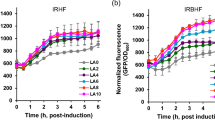Abstract
To produce recombinant β-carotene in vitro, synthetic operons encoding genes governing its biosynthesis were engineered into Escherichia coli. Constructs harboring these operons were introduced into either a high-copy or low-copy cloning vector. β-Carotene production from these recombinant E. coli cells was either constitutive or inducible depending upon plasmid copy number. The most efficient β-carotene production was with the low-copy based vector. The process was increased incrementally from a 5 l to a 50 l fermentor and finally into a 300 l fermentor. The maximal β-carotene yields achieved using the 50 l and 300 l fermentor were 390 mg l−1 and 240 mg l−1, respectively, with overall productivities of 7.8 mg l−1 h−1 and 4.8 mg l−1 h−1.
Similar content being viewed by others
References
Bentley WE, Mirjalili N, Anderson DC, Davis RH, Kompala DS (1990) Plasmid-encoded protein: the principal factor in the metabolic burden associated with recombinant bacteria. Biotechnol Bioeng 35:668–681
Birnbaum S, Bailey JE (1991) Plasmid presence changes the relative levels of many host cell proteins and ribosome components in recombinant Escherichia coli. Biotechnol Bioeng 37:736–745
Glick BR (1995) Metabolic load and heterologous gene expression. Biotechnol Adv 13:247–261
Guzman L, Belin D, Carson MJ, Beckwith J (1995) Tight regulation, modulation, and high-level expression by vectors containing the arabinose PBAD promoter. J Bacteriol 177:4121–4130
Harker M, Bramley PM (1999) Expression of prokaryotic 1-deoxy-d-xylulose-5-phosphatases in Escherichia coli increases carotenoid and ubiquinone biosynthesis. FEBS Lett 448:115–119
Jones KL, Kim SW, Keasling JD (2000) Low-copy plasmids can perform as well as or better than high-copy plasmids for metabolic engineering of bacteria. Metab Eng 2:328–338
Kajiwara S, Fraser PD, Kondo K, Misawa N (1997) Expression of an exogenous isopentenyl diphosphate isomerase gene enhances isoprenoid biosynthesis in Escherichia coli. Biochem J 324:421–426
Kim SW, Keasling JD (2001) Metabolic engineering of the non-mevalonate isopentenyl diphosphate synthesis pathway in Escherichia coli enhances lycopene production. Biotechnol Bioeng 72:408–415
Matthews PD, Wurtzel ET (2000) Metabolic engineering of carotenoid accumulation in Escherichia coli by modulation of the isoprenoid precursor pool with expression of deoxyxylulose phosphate synthase. Appl Microbiol Biotechnol 53:396–400
Misawa N, Nakagawa M, Kobayashi K, Yamano S, Izawa Y, Nakamura K, Harashima K (1990) Elucidation of the Erwinia uredovora carotenoid biosynthetic pathway by functional analysis of gene products expressed in Escherichia coli. J Bacteriol 172:6704–6712
Miura Y, Kondo K, Saito T, Shimada H, Fraser PD, Misawa N (1998) Production of carotenoids lycopene, β-carotene, and astaxanthin in the food yeast Candida utilis. Appl Environ Microbiol 64:1226–1229
Novick A, Weiner M (1957) Enzyme induction as an all-or-none phenomenon. Proc Natl Acad Sci USA 43:553–556
Sandmann G, Albrecht M, Schnurr G, Knorzer O, Boger P (1999) The biotechnological potential and design of novel carotenoids by gene combination in Escherichia coli. Trends Biotechnol 17:233–237
Siegele DA, Hu JC (1997) Gene expression from plasmids containing the araBAD promoter at subsaturating inducer concentrations represents mixed populations. Proc Natl Acad Sci USA 94:8168–8172
Umeno D, Tobias AV, Arnold FH (2002) Evolution of the C30 carotenoid synthase crtM for function in a C40 pathway. J Bacteriol 184:6690–6699
Vind J, Sorensen M, Rasmussen M, Pedeson S (1993) Synthesis of proteins in Escherichia coli is limited by the concentration of free ribosomes. J Mol Biol 231:678–688
Wang CW, Oh MK, Liao JC (1999) Engineered isoprenoid pathway enhances astaxanthin production in Escherichia coli. Biotechnol Bioeng 62:235–241
Acknowledgments
This study was supported by a grant from the Korea Health 21 R & D Project, Ministry of Health & Welfare, Republic of Korea (A020547).
Author information
Authors and Affiliations
Corresponding author
Rights and permissions
About this article
Cite this article
Kim, SW., Kim, JB., Jung, H. et al. Over-production of β-carotene from metabolically engineered Escherichia coli . Biotechnol Lett 28, 897–904 (2006). https://doi.org/10.1007/s10529-006-9023-9
Received:
Revised:
Accepted:
Published:
Issue Date:
DOI: https://doi.org/10.1007/s10529-006-9023-9




